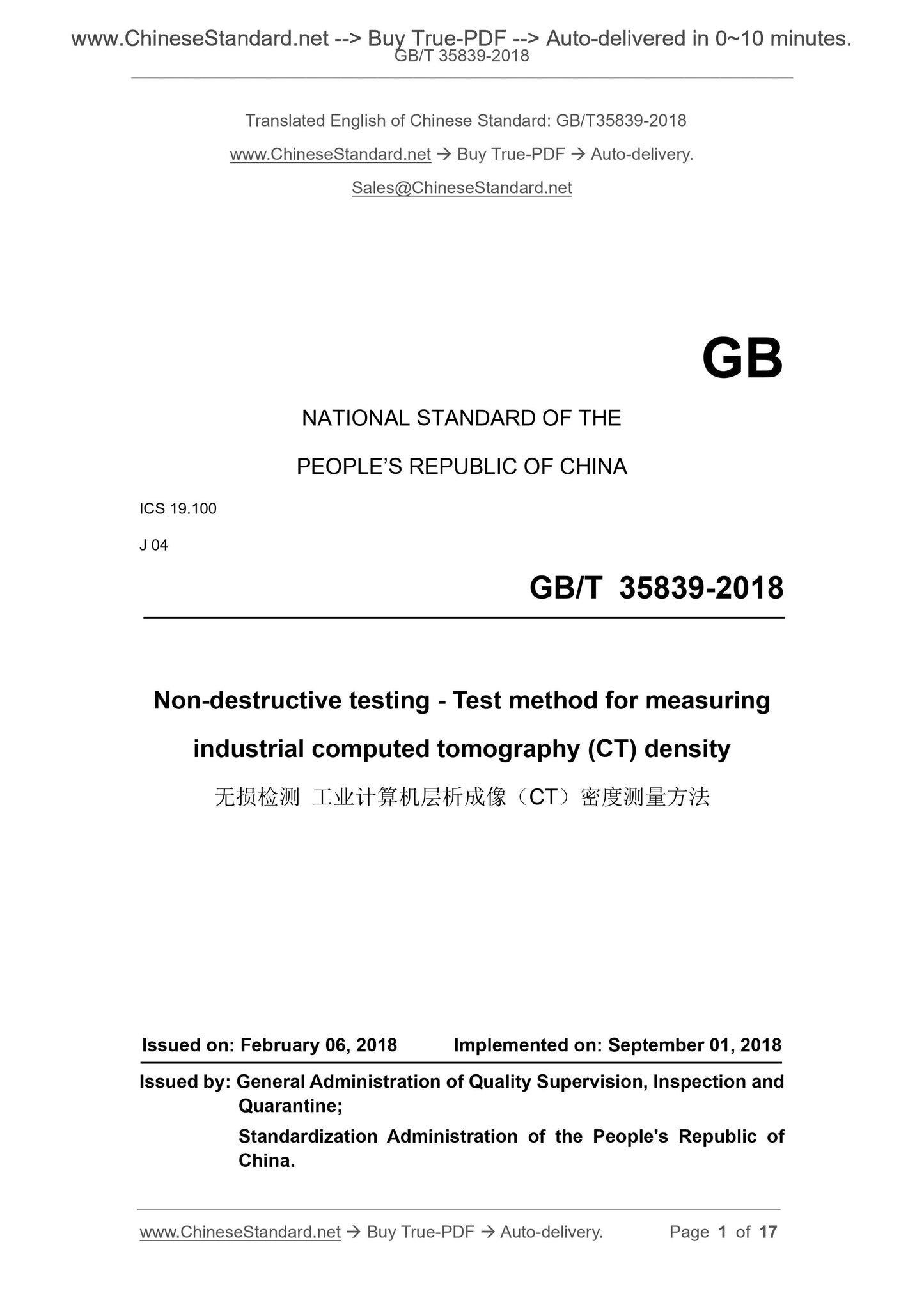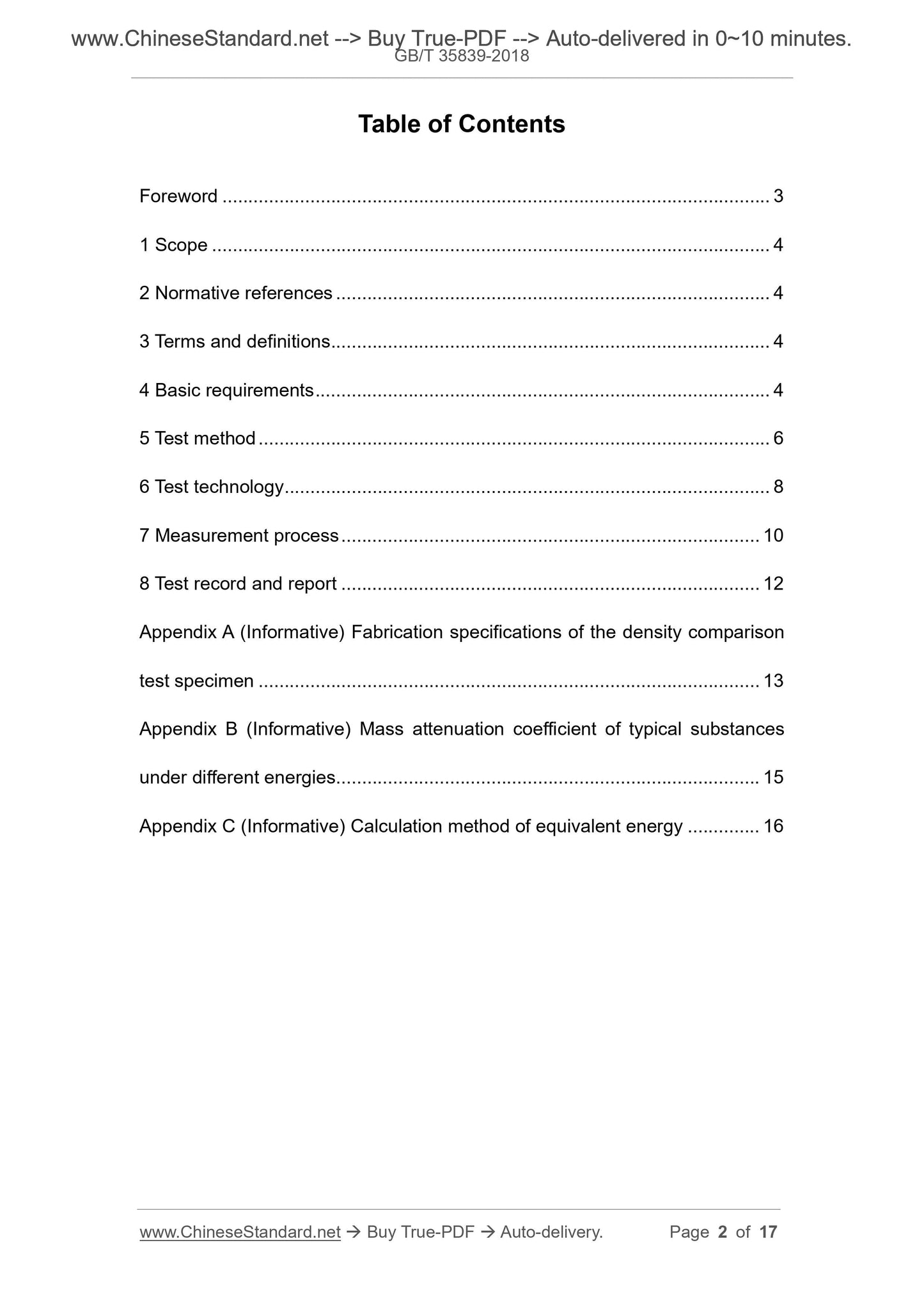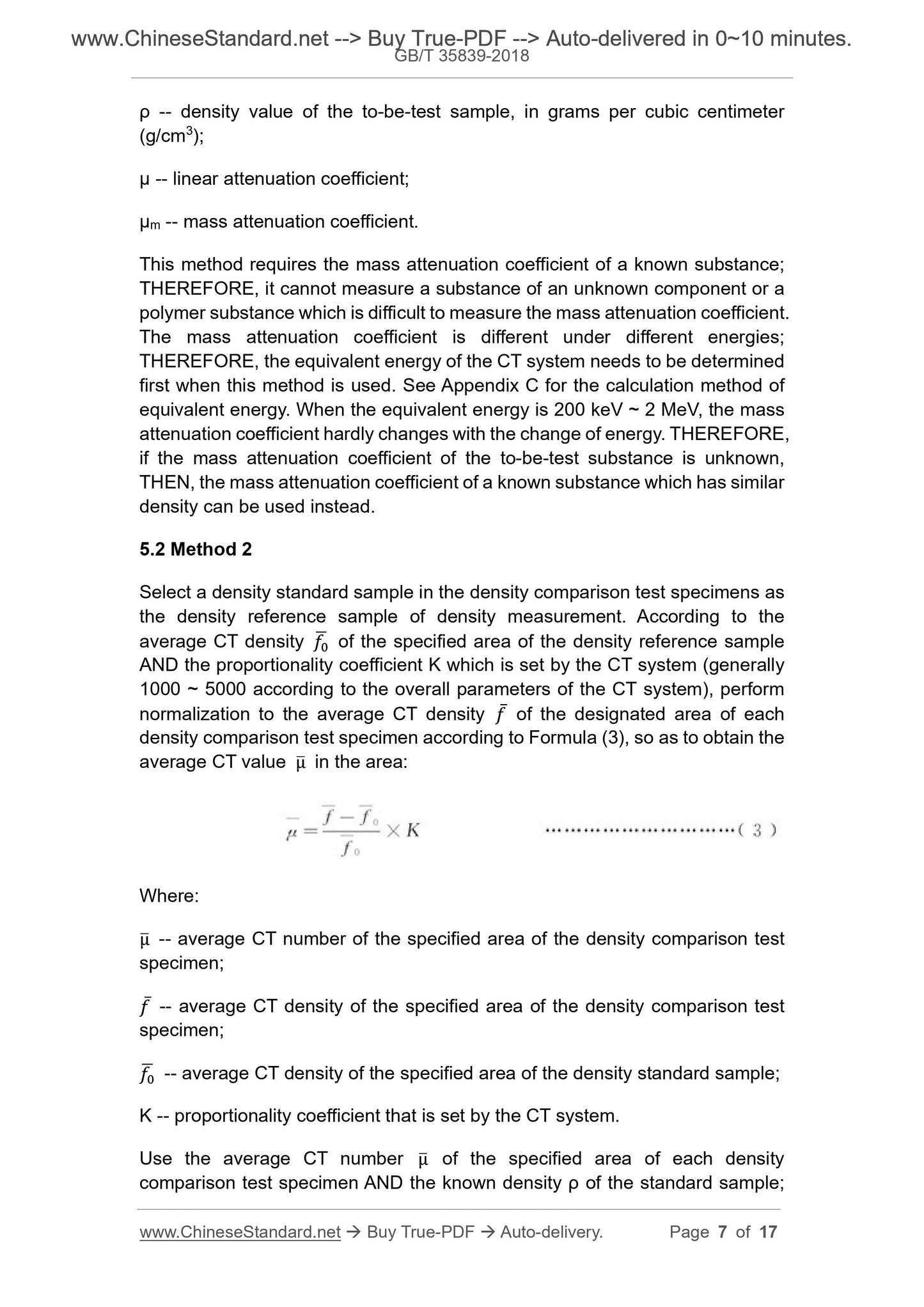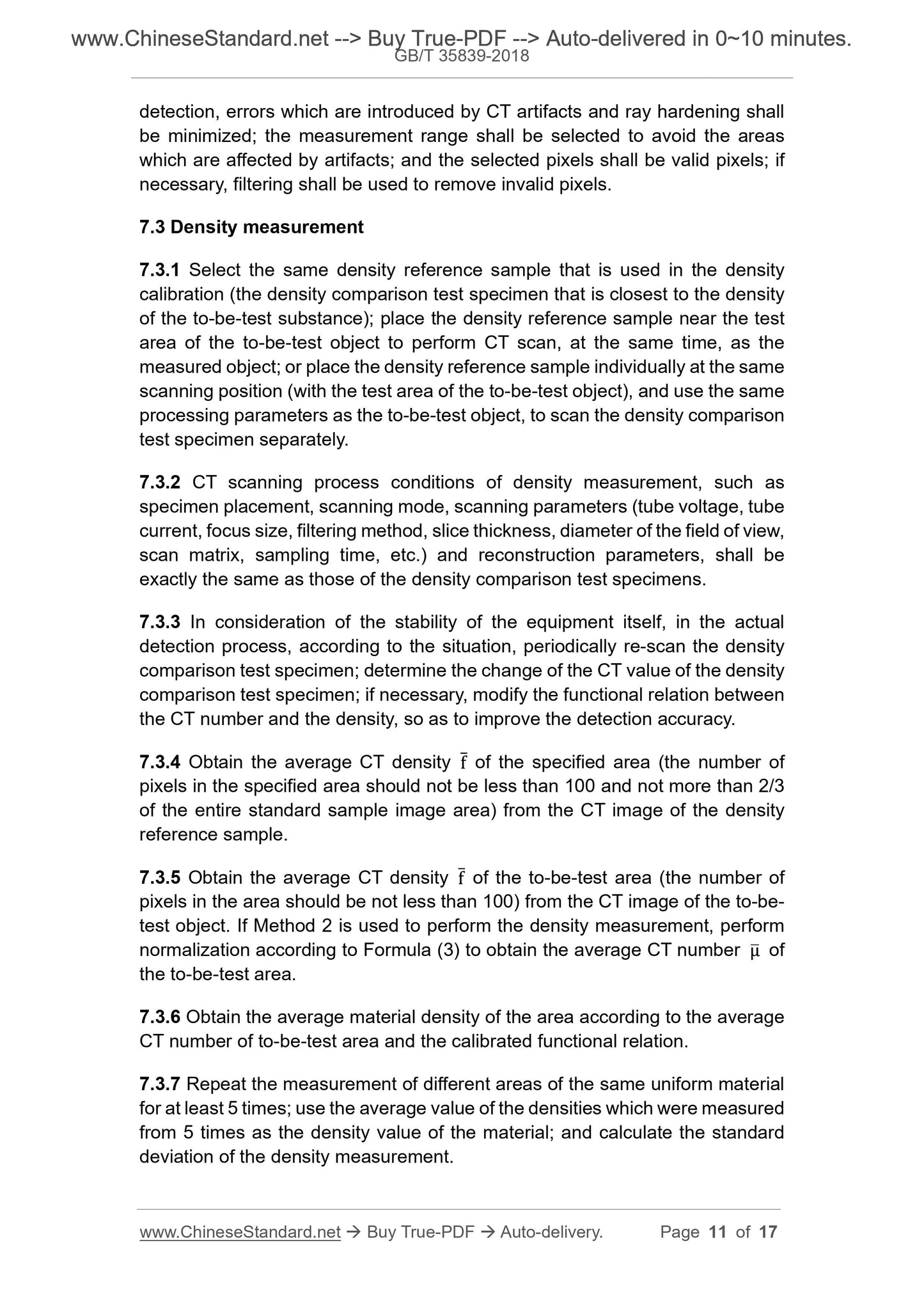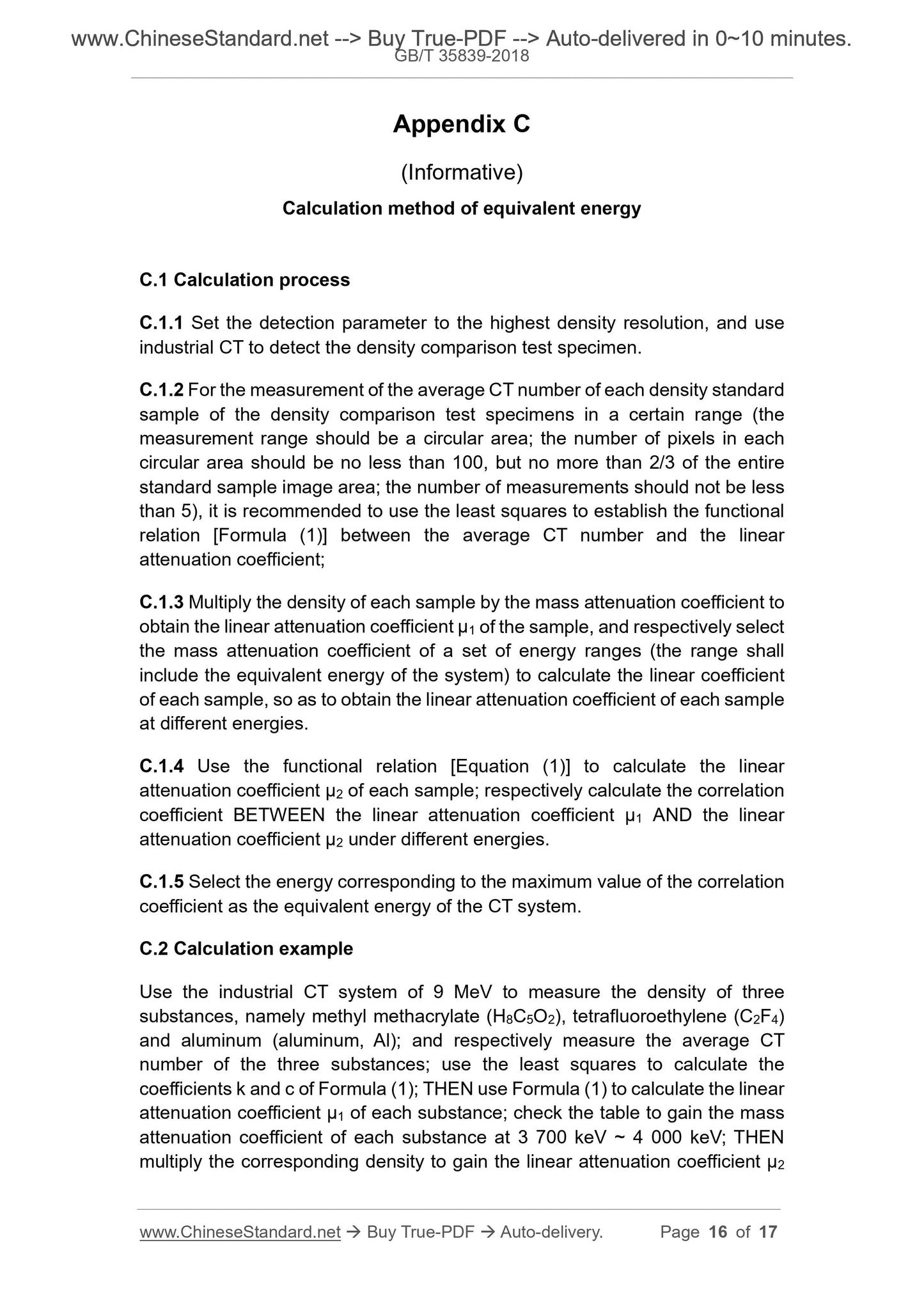PayPal, credit cards. Download editable-PDF & invoice in 1 second!
GB/T 35839-2018 English PDF (GBT35839-2018)
GB/T 35839-2018 English PDF (GBT35839-2018)
Precio habitual
$210.00 USD
Precio habitual
Precio de oferta
$210.00 USD
Precio unitario
/
por
Los gastos de envío se calculan en la pantalla de pago.
No se pudo cargar la disponibilidad de retiro
Delivery: 3 seconds. Download true-PDF + Invoice.
Get QUOTATION in 1-minute: Click GB/T 35839-2018
Historical versions: GB/T 35839-2018
Preview True-PDF (Reload/Scroll if blank)
GB/T 35839-2018: Non-destructive testing -- Test method for measuring industrial computed tomography (CT) density
GB/T 35839-2018
NATIONAL STANDARD OF THE
PEOPLE’S REPUBLIC OF CHINA
ICS 19.100
J 04
Non-destructive testing - Test method for measuring
industrial computed tomography (CT) density
ISSUED ON: FEBRUARY 06, 2018
IMPLEMENTED ON: SEPTEMBER 01, 2018
Issued by: General Administration of Quality Supervision, Inspection and
Quarantine;
Standardization Administration of the People's Republic of
China.
Table of Contents
Foreword ... 3
1 Scope ... 4
2 Normative references ... 4
3 Terms and definitions ... 4
4 Basic requirements ... 4
5 Test method ... 6
6 Test technology ... 8
7 Measurement process ... 10
8 Test record and report ... 12
Appendix A (Informative) Fabrication specifications of the density comparison
test specimen ... 13
Appendix B (Informative) Mass attenuation coefficient of typical substances
under different energies ... 15
Appendix C (Informative) Calculation method of equivalent energy ... 16
Non-destructive testing - Test Method for Measuring
Industrial Computed Tomography (CT)
1 Scope
This Standard specifies the methods to use industrial computed tomography
(CT) to measure the density of objects.
This Standard is applicable to industrial CT systems, of which the energy range
is 200keV ~ 10 MeV, and which perform density-measurement of common
metal and non-metallic materials.
2 Normative references
The following documents are indispensable for the application of this document.
For dated references, only the dated version applies to this document. For
undated references, the latest edition (including all amendments) applies to this
document.
GB/T 9445 Non-destructive testing - Qualification and certification of NDT
personnel (GB/T 9445-2015, ISO 09712:2012, IDT)
GB/T 29069 Non-destructive testing. Test method for measurement of
industrial computed tomography (CT) system performance
GB/T 29070 Non-destructive testing. Industrial computed tomography (CT)
testing. General requirements
GB/T 34365 Non-destructive testing. Terminology. Terms used in industrial
computed tomography testing
3 Terms and definitions
Terms and definitions determined by GB/T 34365 and the following ones are
applicable to this document.
4 Basic requirements
4.1 Test personnel
4.1.1 Personnel engaged in industrial CT density measurement shall meet the
ρ -- density value of the to-be-test sample, in grams per cubic centimeter
(g/cm3);
µ -- linear attenuation coefficient;
µm -- mass attenuation coefficient.
This method requires the mass attenuation coefficient of a known substance;
THEREFORE, it cannot measure a substance of an unknown component or a
polymer substance which is difficult to measure the mass attenuation coefficient.
The mass attenuation coefficient is different under different energies;
THEREFORE, the equivalent energy of the CT system needs to be determined
first when this method is used. See Appendix C for the calculation method of
equivalent energy. When the equivalent energy is 200 keV ~ 2 MeV, the mass
attenuation coefficient hardly changes with the change of energy. THEREFORE,
if the mass attenuation coefficient of the to-be-test substance is unknown,
THEN, the mass attenuation coefficient of a known substance which has similar
density can be used instead.
5.2 Method 2
Select a density standard sample in the density comparison test specimens as
the density reference sample of density measurement. According to the
average CT density of the specified area of the density reference sample
AND the proportionality coefficient K which is set by the CT system (generally
1000 ~ 5000 according to the overall parameters of the CT system), perform
normalization to the average CT density of the designated area of each
density comparison test specimen according to Formula (3), so as to obtain the
average CT value in the area:
Where:
-- average CT number of the specified area of the density comparison test
specimen;
-- average CT density of the specified area of the density comparison test
specimen;
-- average CT density of the specified area of the density standard sample;
K -- proportionality coefficient that is set by the CT system.
Use the average CT number of the specified area of each density
comparison test specimen AND the known density ρ of the standard sample;
detection, errors which are introduced by CT artifacts and ray hardening shall
be minimized; the measurement range shall be selected to avoid the areas
which are affected by artifacts; and the selected pixels shall be valid pixels; if
necessary, filtering shall be used to remove invalid pixels.
7.3 Density measurement
7.3.1 Select the same density reference sample that is used in the density
calibration (the density comparison test specimen that is closest to the density
of the to-be-test substance); place the density reference sample near the test
area of the to-be-test object to perform CT scan, at the same time, as the
measured object; or place the density reference sample individually at the same
scanning position (with the test area of the to-be-test object), and use the same
processing parameters as the to-be-test object, to scan the density comparison
test specimen separately.
7.3.2 CT scanning process conditions of density measurement, such as
specimen placement, scanning mode, scanning parameters (tube voltage, tube
current, focus size, filtering method, slice thickness, diameter of the field of view,
scan matrix, sampling time, etc.) and reconstruction parameters, shall be
exactly the same as those of the density comparison test specimens.
7.3.3 In consideration of the stability of the equipment itself, in the actual
detection process, according to the situation, periodically re-scan the density
comparison test specimen; determine the change of the CT value of the density
comparison test specimen; if necessary, modify the functional relation between
the CT number and the density, so as to improve the detection accuracy.
7.3.4 Obtain the average CT density of the specified area (the number of
pixels in the specified area should not be less than 100 and not more than 2/3
of the entire standard sample image area) from the CT image of the density
reference sample.
7.3.5 Obtain the average CT density of the to-be-test area (the number of
pixels in the area should be not less than 100) from the CT image of the to-be-
test object. If Method 2 is used to perform the density measurement, perform
normalization according to Formula (3) to obtain the average CT number of
the to-be-test area.
7.3.6 Obtain the average material density of the area according to the average
CT number of to-be-test area and the calibrated functional relation.
7.3.7 Repeat the measurement of different areas of the same uniform material
for at least 5 times; use the average value of the densities which were measured
from 5 times as the density value of the material; and calculate the standard
deviation of the density measurement.
Appendix C
(Informative)
Calculation method of equivalent energy
C.1 Calculation process
C.1.1 Set the detection parameter to the highest density resolution, and use
industrial CT to detect the density comparison test specimen.
C.1.2 For the measurement of the average CT number of each density standard
sample of the density comparison test specimens in a certain range (the
measurement range should be a circular area; the number of pixel...
Get QUOTATION in 1-minute: Click GB/T 35839-2018
Historical versions: GB/T 35839-2018
Preview True-PDF (Reload/Scroll if blank)
GB/T 35839-2018: Non-destructive testing -- Test method for measuring industrial computed tomography (CT) density
GB/T 35839-2018
NATIONAL STANDARD OF THE
PEOPLE’S REPUBLIC OF CHINA
ICS 19.100
J 04
Non-destructive testing - Test method for measuring
industrial computed tomography (CT) density
ISSUED ON: FEBRUARY 06, 2018
IMPLEMENTED ON: SEPTEMBER 01, 2018
Issued by: General Administration of Quality Supervision, Inspection and
Quarantine;
Standardization Administration of the People's Republic of
China.
Table of Contents
Foreword ... 3
1 Scope ... 4
2 Normative references ... 4
3 Terms and definitions ... 4
4 Basic requirements ... 4
5 Test method ... 6
6 Test technology ... 8
7 Measurement process ... 10
8 Test record and report ... 12
Appendix A (Informative) Fabrication specifications of the density comparison
test specimen ... 13
Appendix B (Informative) Mass attenuation coefficient of typical substances
under different energies ... 15
Appendix C (Informative) Calculation method of equivalent energy ... 16
Non-destructive testing - Test Method for Measuring
Industrial Computed Tomography (CT)
1 Scope
This Standard specifies the methods to use industrial computed tomography
(CT) to measure the density of objects.
This Standard is applicable to industrial CT systems, of which the energy range
is 200keV ~ 10 MeV, and which perform density-measurement of common
metal and non-metallic materials.
2 Normative references
The following documents are indispensable for the application of this document.
For dated references, only the dated version applies to this document. For
undated references, the latest edition (including all amendments) applies to this
document.
GB/T 9445 Non-destructive testing - Qualification and certification of NDT
personnel (GB/T 9445-2015, ISO 09712:2012, IDT)
GB/T 29069 Non-destructive testing. Test method for measurement of
industrial computed tomography (CT) system performance
GB/T 29070 Non-destructive testing. Industrial computed tomography (CT)
testing. General requirements
GB/T 34365 Non-destructive testing. Terminology. Terms used in industrial
computed tomography testing
3 Terms and definitions
Terms and definitions determined by GB/T 34365 and the following ones are
applicable to this document.
4 Basic requirements
4.1 Test personnel
4.1.1 Personnel engaged in industrial CT density measurement shall meet the
ρ -- density value of the to-be-test sample, in grams per cubic centimeter
(g/cm3);
µ -- linear attenuation coefficient;
µm -- mass attenuation coefficient.
This method requires the mass attenuation coefficient of a known substance;
THEREFORE, it cannot measure a substance of an unknown component or a
polymer substance which is difficult to measure the mass attenuation coefficient.
The mass attenuation coefficient is different under different energies;
THEREFORE, the equivalent energy of the CT system needs to be determined
first when this method is used. See Appendix C for the calculation method of
equivalent energy. When the equivalent energy is 200 keV ~ 2 MeV, the mass
attenuation coefficient hardly changes with the change of energy. THEREFORE,
if the mass attenuation coefficient of the to-be-test substance is unknown,
THEN, the mass attenuation coefficient of a known substance which has similar
density can be used instead.
5.2 Method 2
Select a density standard sample in the density comparison test specimens as
the density reference sample of density measurement. According to the
average CT density of the specified area of the density reference sample
AND the proportionality coefficient K which is set by the CT system (generally
1000 ~ 5000 according to the overall parameters of the CT system), perform
normalization to the average CT density of the designated area of each
density comparison test specimen according to Formula (3), so as to obtain the
average CT value in the area:
Where:
-- average CT number of the specified area of the density comparison test
specimen;
-- average CT density of the specified area of the density comparison test
specimen;
-- average CT density of the specified area of the density standard sample;
K -- proportionality coefficient that is set by the CT system.
Use the average CT number of the specified area of each density
comparison test specimen AND the known density ρ of the standard sample;
detection, errors which are introduced by CT artifacts and ray hardening shall
be minimized; the measurement range shall be selected to avoid the areas
which are affected by artifacts; and the selected pixels shall be valid pixels; if
necessary, filtering shall be used to remove invalid pixels.
7.3 Density measurement
7.3.1 Select the same density reference sample that is used in the density
calibration (the density comparison test specimen that is closest to the density
of the to-be-test substance); place the density reference sample near the test
area of the to-be-test object to perform CT scan, at the same time, as the
measured object; or place the density reference sample individually at the same
scanning position (with the test area of the to-be-test object), and use the same
processing parameters as the to-be-test object, to scan the density comparison
test specimen separately.
7.3.2 CT scanning process conditions of density measurement, such as
specimen placement, scanning mode, scanning parameters (tube voltage, tube
current, focus size, filtering method, slice thickness, diameter of the field of view,
scan matrix, sampling time, etc.) and reconstruction parameters, shall be
exactly the same as those of the density comparison test specimens.
7.3.3 In consideration of the stability of the equipment itself, in the actual
detection process, according to the situation, periodically re-scan the density
comparison test specimen; determine the change of the CT value of the density
comparison test specimen; if necessary, modify the functional relation between
the CT number and the density, so as to improve the detection accuracy.
7.3.4 Obtain the average CT density of the specified area (the number of
pixels in the specified area should not be less than 100 and not more than 2/3
of the entire standard sample image area) from the CT image of the density
reference sample.
7.3.5 Obtain the average CT density of the to-be-test area (the number of
pixels in the area should be not less than 100) from the CT image of the to-be-
test object. If Method 2 is used to perform the density measurement, perform
normalization according to Formula (3) to obtain the average CT number of
the to-be-test area.
7.3.6 Obtain the average material density of the area according to the average
CT number of to-be-test area and the calibrated functional relation.
7.3.7 Repeat the measurement of different areas of the same uniform material
for at least 5 times; use the average value of the densities which were measured
from 5 times as the density value of the material; and calculate the standard
deviation of the density measurement.
Appendix C
(Informative)
Calculation method of equivalent energy
C.1 Calculation process
C.1.1 Set the detection parameter to the highest density resolution, and use
industrial CT to detect the density comparison test specimen.
C.1.2 For the measurement of the average CT number of each density standard
sample of the density comparison test specimens in a certain range (the
measurement range should be a circular area; the number of pixel...
Share
